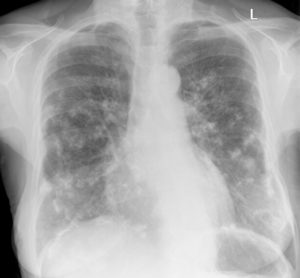Lung Cancer from Asbestos Life Expectancy
 Life expectancy refers to how long a patient can be expected to live after receiving an asbestos lung cancer diagnosis. It’s part of an overall asbestos lung cancer prognosis or projected health outcome.
Life expectancy refers to how long a patient can be expected to live after receiving an asbestos lung cancer diagnosis. It’s part of an overall asbestos lung cancer prognosis or projected health outcome.
The average asbestos lung cancer life expectancy ranges from a few months to several years. It varies depending on the type of lung cancer a patient has, the stage it’s diagnosed in, and other factors.
There are two main types of lung cancer:
- Non-Small Cell Lung Cancer (NSCLC): This is the most common type of lung cancer. The life expectancy ranges from 57 months in early stages to just 5 months in the end stages, according to the medical journal JAMA Network.
- Small Cell Lung Cancer (SCLC): This type is much rarer than NSCLC and more aggressive. The average small cell lung cancer life expectancy is only 7-16 months.
Some asbestos lung cancer life expectancy figures can seem grim. But it’s important to remember that you might be able to outlive your asbestos lung cancer life expectancy with medical care.
Call Sokolove Law now at (800) 647-3434 to see if we can help you get compensation for your treatment.
Asbestos Lung Cancer Survival Rate
Asbestos lung cancer survival rates are not the same figures as life expectancies, though both play important roles in determining your prognosis:
- Life expectancy refers to the average amount of time someone lives after being diagnosed
- Survival rate refers to the percent of people with the same stage and type of cancer who are still alive after a certain period of time
The overall 5-year survival rate for lung cancer is 18.6% as noted by the American Lung Association.
Mesothelioma vs. Lung Cancer Survival Rates
People who are exposed to asbestos are at risk of many asbestos-related diseases other than lung cancer, including mesothelioma and asbestosis:
- The most common type of the mesothelioma forms in the lining of the lungs and has a 5-year survival rate of 12%, according to the American Cancer Society
- Asbestosis, a noncancerous illness that weakens the lungs over time, can be fatal, but many patients live for several years after a diagnosis
However, the Environmental Working Group (EWG) found that asbestos-related lung cancer is responsible for thousands of more deaths per year than mesothelioma and asbestosis combined.
If you were diagnosed with an asbestos-related disease, Sokolove Law may be able to help you hold the companies responsible for your exposure accountable.
Get Help for Asbestos Lung Cancer
We've secured over $5.7 Billion for thousands with lung cancer, mesothelioma, and more. We'll fight to get you everything you're entitled to.
Factors Affecting Asbestos Lung Expectancy
There are multiple factors that can affect someone’s life expectancy with lung cancer. Besides the type of lung cancer a patient has, stage, age, a patient’s health, and more all play a role.
Lung Cancer Stages & Life Expectancy
 What the stage the cancer is in at the time of diagnosis greatly impacts asbestos lung cancer life expectancy.
What the stage the cancer is in at the time of diagnosis greatly impacts asbestos lung cancer life expectancy.
Higher stages mean that the cancer has spread further through the body and is more difficult to treat. This, in turn, will mean that the patient has less time to live.
Unfortunately, by the time more noticeable lung cancer symptoms appear, patients are usually in a more advanced stage with fewer treatment options.
SCLC has two stages:
- Limited-stage SCLC has a life expectancy of 12-16 months, according to the Canadian Cancer Society
- Extensive-stage SCLC has a life expectancy of 7-11 months
On the other hand, NSCLC has four stages, with stage 1 being the easiest to treat and stage 4 the most difficult:
| Average NSCLC Life Expectancies by Stage | |
|---|---|
| Stages 1-2 | 57 months |
| Stage 3 | 12 months |
| Stage 4 (metastatic) | 5 months |
| Stage not identified | 10 months |
Patient Age
A person diagnosed with asbestos-related lung cancer at a younger age is less likely to die than someone who’s older and may be battling other health conditions.
“Age is a significant risk factor for lung cancer mortality, with peak mortality occurring in patients aged ≥80 years.”
– ERS Publications
However, it’s generally rare for young people to be diagnosed with asbestos lung cancer as it can take several decades to develop after exposure to asbestos.
Patient Health
 Patients may live longer with lung cancer if they were in good overall health and didn’t have any other major medical issues before diagnosis.
Patients may live longer with lung cancer if they were in good overall health and didn’t have any other major medical issues before diagnosis.
For example, early-stage NSCLC lung cancer patients had a worse prognosis if they had comorbidities (other health problems) at the time of diagnosis, in a study published in MDPI.
A person in good health may have a stronger immune system that can fight cancer more effectively.
Connect with Sokolove Law at (800) 647-3434 if you or a loved one has lung cancer and was exposed to asbestos decades ago.
Asbestos Cancer Lung Life Expectancy with Treatment
There currently is no cure for asbestos lung cancer — but doctors can often use treatments to improve the life expectancy of lung cancer patients.
Treatment options for asbestos lung cancer include:
- Chemotherapy: These medications destroy cancer tumors. In a study highlighted by the National Cancer Institute (NCI), late-stage NSCLC lung cancer patients treated with chemotherapy lived for over 10 months. Additionally, a Radiation Oncology study found that chemotherapy and radiation helped limited-stage SCLC patients live for 52 months on average.
- Radiation therapy: This type of cancer treatment uses X-rays or other forms of radioactive energy to attack cancer cells. Early-stage NSCLC patients treated with radiation therapy lived over 40 months on average.
- Surgery: Surgery allows doctors to take out lung cancer tumors. It’s usually only used to treat early-stage NSCLC, which it can sometimes cure. NSCLC patients treated with surgery lived for an average of 35 months, according to the Journal of Cardiovascular Surgery.
- Immunotherapy: This type of cancer treatment utilizes the patient’s own immune system to fight cancer cells. Extensive-stage SCLC patients treated with immunotherapy and chemotherapy typically lived for nearly 13 months, according to an Advances in Therapy report.
- Clinical trials: Patients can participate in cancer research by joining a clinical trial, where new and innovative treatments are tested or existing ones are improved.
Unfortunately, the cost of lung cancer treatments can add up quickly. Filing an asbestos lawsuit may allow you to receive lung cancer compensation that can be used towards medical expenses, travel costs, and more.
Get Help Paying for Treatment
You may be eligible for asbestos lung cancer compensation that we can fight for on your behalf. Let us get you the results you deserve.
Improving Asbestos Lung Cancer Life Expectancy
If you or someone you love has been diagnosed with asbestos lung cancer or mesothelioma, there are some steps you can take to potentially improve your life expectancy.
You may be able to improve your lung cancer caused by asbestos life expectancy by:
- Maintaining healthy lifestyle habits, like a good diet and regular exercise routine
- Seeking social support systems
- Considering approved alternative treatments in addition to traditional ones
Remember: Getting medical treatment is the best way to live longer after a lung cancer diagnosis.
A doctor can recommend a treatment plan and tell you more about how to boost your asbestos lung cancer life expectancy.
Get Help from Our Asbestos Lung Cancer Lawyers
To afford treatments that can help improve your lung cancer life expectancy, you can file an asbestos lung cancer lawsuit and pursue compensation with Sokolove Law.
As a national mesothelioma and lung cancer law firm, Sokolove Law has handled asbestos exposure lawsuits for more than 45 years.
We've secured over $5.7 Billion for thousands of clients with lung cancer, mesothelioma, and other asbestos-related diseases nationwide.
Call (800) 647-3434 now for a free case review to see if our asbestos lung cancer lawyers can help you. Our team can also help you find lung cancer treatment options.
Asbestos in Lungs Life Expectancy FAQs
What is the stage 4 lung cancer life expectancy?
Only non-small cell lung cancer is classified into four stages. Stage 4 NSCLC patients have a life expectancy of just 5 months, according to a JAMA Network study.
However, it may be possible to outlive the average asbestos lung cancer life expectancy by getting medical treatments.
Call (800) 647-3434 now for free help determining if you qualify for lung cancer compensation.
How long can someone live with asbestos-related lung cancer?
The estimated average life expectancy for someone with non-small cell lung cancer is 5-57 months, while the estimated life expectancy of small cell lung cancer patients is 7-16 months.
However, asbestos lung cancer life expectancies depend on multiple factors, including the:
- Patient’s age and overall health
- Stage of their cancer
- The type of lung cancer they have
That said, with early detection and aggressive treatment, some patients can become long-term lung cancer survivors.
Can you cure asbestos lung cancer?
It depends. There is no known official cure for lung cancer, whether it’s caused by asbestos or not. That said, some patients may be considered ‘cured’ if the cancer is aggressively treated in its early stages.
Treatments can often improve late-stage patients’ quality of life and possibly extend asbestos lung cancer life expectancy.
Certain patients “who are told that their lung cancer is incurable live longer than many who are told that their lung cancer is curable,” according to the American Society of Clinical Oncology.
Can asbestos lung cancer go into remission?
Yes, in some cases. Remission is when signs of cancer lessen or disappear, usually thanks to treatment. Patients may have a better asbestos lung cancer life expectancy if remission occurs.
While it’s possible for lung cancer to go into remission, patients should continue to undergo regular screenings to check for cancer recurrence (when the cancer comes back).
Unfortunately, lung cancer patients exposed to asbestos at their jobs might be at higher risk of recurrence and disease progression, according to Boston Lung Cancer Survival Cohort.
What are the stages of asbestos lung cancer?
Non-small cell asbestos lung cancer typically progresses through four main stages. The higher the stage, the lower the average asbestos lung cancer life expectancy.
Early-stage NSCLC patients have an estimated average life expectancy of 57 months, while the stage 4 NSCLC life expectancy is just 5 months.
Small cell lung cancer only has two stages:
- Limited-stage SCLC, when the cancer is only in one lung, has a life expectancy of 12-16 months
- Extensive-stage SCLC, when the cancer has spread to both lungs or other parts of the body, has an average survival time of 7-11 months
What is the life expectancy for asbestos lung cancer without treatment?
Patients who don’t get treatment have a very poor asbestos lung cancer life expectancy.
NSCLC patients that don’t get treated live for just over 7 months on average, according to a report from the journal Systematic Reviews.
Untreated SCLC has an even lower life expectancy without treatment, ranging from just 2-4 months, according to Advances in Therapy.
